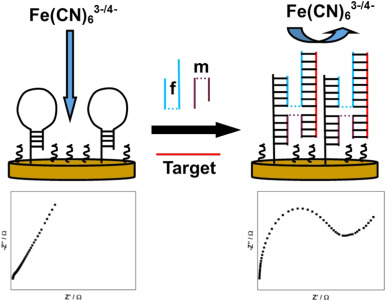Авторы: Mills D.M., Martin C.P., Armas S.M., Calvo-Marzala P.,, Chumbimuni-Torres K.Y.

Abstract
We report a label-free universal biosensing platform for highly selective detection of long nucleic acid strands. The sensor consists of an electrode-immobilized universal stem-loop (USL) probe and two adaptor strands that form a 4J structure in the presence of a specific DNA/RNA analyte. The sensor was characterized by electrochemical impedance spectroscopy (EIS) using K3[Fe(CN)6]/K4[Fe(CN)6] redox couple in solution. An increase in charge transfer resistance (RCT) was observed upon 4J structure formation, the value of which depends on the analyte length. Cyclic voltammetry (CV) was used to further characterize the sensor and monitor the electrochemical reaction in conjunction with thickness measurements of the mixed DNA monolayer obtained using spectroscopic ellipsometry. In addition, the electron transfer was calculated at the electrode/electrolyte interface using a rotating disk electrode. Limits of detection in the femtomolar range were achieved for nucleic acid targets of different lengths (22 nt, 60 nt, 200 nt). The sensor produced only a background signal in the presence of single base mismatched analytes, even in hundred times excess in concentration. This label-free and highly selective biosensing platform is versatile and can be used for universal detection of nucleic acids of varied lengths which could revolutionize point of care diagnostics for applications such as bacterial or cancer screening.
Keywords: four-way junction; electrochemical impedance spectroscopy; label-free; universal sensor.
DOI: 10.1016/j.bios.2018.02.059.
Read Full: https://www.sciencedirect.com/science/article/pii/S095656631830160X.